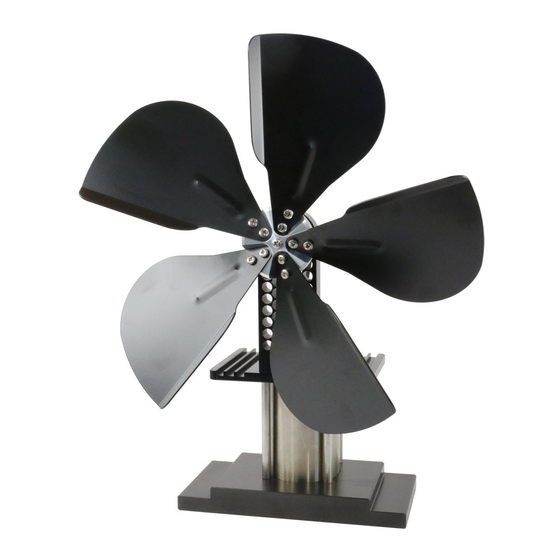
Advertisement
WARNING:
DO NOT OIL YOUR FAN
The stove fan is designed to not need regular oiling. Oil applied to
the ball bearings or piston WILL have a detrimental effect on your
engine and will void the warranty. It is a precision piece of
engineering. In order to retain its efficiency it must be kept clean
and dust free. Keep away from any frying/sauce pans that are being
used on the stove, as this has been known to splatter oil onto the
stove fan and stop it from working.
Handling your fan
The fan will be very hot while in operation and will take time to cool
down once removed from the stove. If removing from the stove
place on something that can withstand the heat. Your stove fan can
be picked up by the blades when idle. This is particularly useful if the
stove fan is still hot.
Fitting the fan blade
Take the main unit and place on a flat surface (First picture above). Fit hub onto axle and secure with 1 long screw (as
shown in second picture above). Tighten screw to medium hand tightness with screwdriver. Fit each fan blade 'petal'
one by one (third picture above). Using two screws for each 'petal'. PUT BOTH SCREWS in loosely before tightening
both to medium hand tightness.
Ver. 6
01/10/2016
Vulcan Stove Fan Manual
Using your fan
Once your stove is up to temperature, place the Stove Fan on the stove. Wait
until the base has heated (this should take only a few minutes) and then
gently spin the fan clockwise, with enough force to allow the blades to rotate
a few times. The fan will start to rotate slowly at first but will gain momentum.
The higher the temperature of the stove, the faster the fan will operate. In
ideal conditions the stove fan will run on a surface temperature as low 150 C
(300F). 175C (350F) or higher and the stove fan should be easy to start. When
measuring stove temperatures place a stove thermometer next to the fan on
top of the stove surface. Flue temperatures and sides of the stove are likely to
be different temperatures. That's not always obvious!
Not working?
If the stove fan is not working check the connecting rods (see page 2). This is a
fairly common cause of not running. You may also want to check your stove
temperature. Every stove owner thinks they have a super hot stove. In truth
stove temperatures vary. The stove fan runs on most stoves but there are
stoves that run at lower temperatures.
Page 1 of 2
Advertisement
Table of Contents

Summary of Contents for Gyroscope.com Vulcan Stove Fan
- Page 1 Vulcan Stove Fan Manual WARNING: DO NOT OIL YOUR FAN The stove fan is designed to not need regular oiling. Oil applied to the ball bearings or piston WILL have a detrimental effect on your engine and will void the warranty. It is a precision piece of engineering.
- Page 2 The Vulcan's fan speed increases relative to the temperature increase of its heat source. So, the hotter your stove, the faster the Vulcan will run and the higher the volume of air circulated. The Vulcan stove fan uses the latest and best technology, including borosilicate glass cylinder, graphite piston and ultra-low friction demagnetised bearings.
Need help?
Do you have a question about the Vulcan Stove Fan and is the answer not in the manual?
Questions and answers